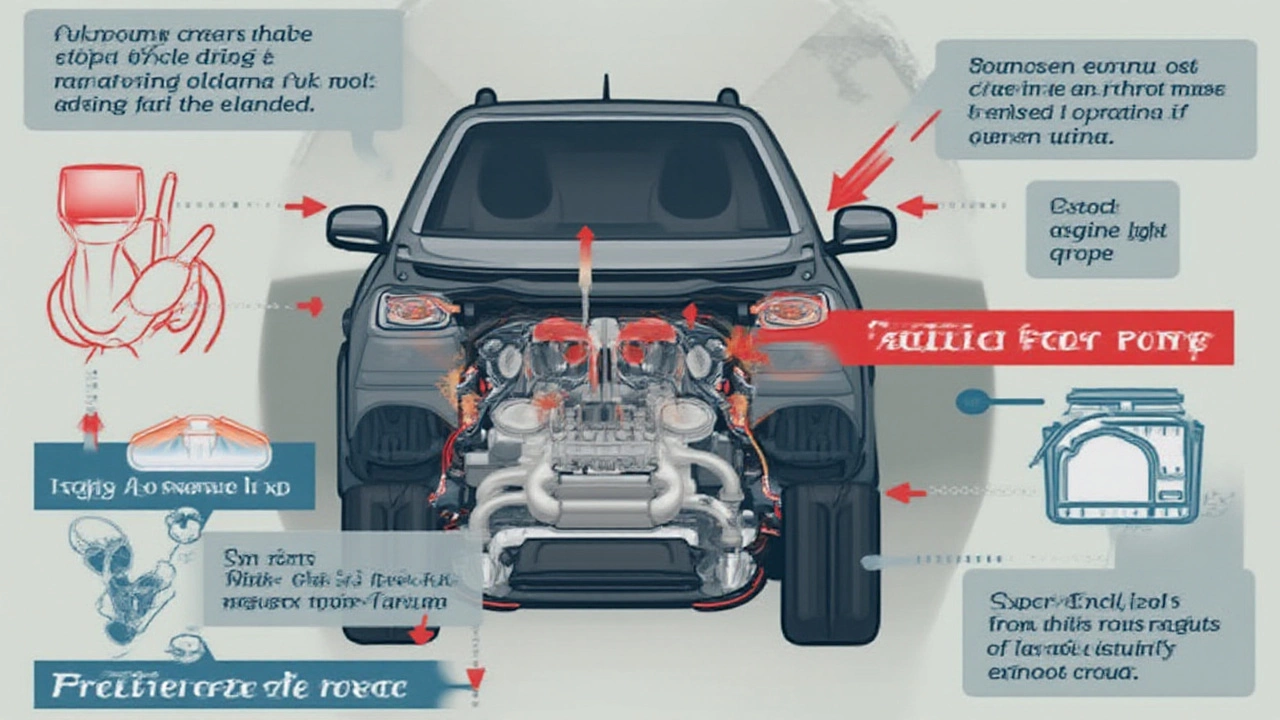Ever had your car sputter at a green light, refusing to accelerate while the driver behind you lays on the horn? That moment of panic isn’t just embarrassing—a failing fuel pump could be the reason, and the stakes are higher than you might think. Most drivers hear about fuel pumps only when there’s a problem, and by the time symptoms show up, things can get messy fast. We’re talking breakdowns in the worst spots: roundabouts, intersections, or, if luck really hates you, the middle lane of a freeway during rush hour. The big question: Is it even safe, or smart, to keep driving once you know your fuel pump’s on the fritz?
How Fuel Pumps Work (and Why They Matter)
Let’s start simple. Your car’s fuel pump sits nestled in the gas tank, pushing fuel through the lines to the engine on demand. Think of it as the heart of your fuel system, pumping lifeblood to keep the engine alive. Without it, your engine is just a block of expensive metal. In modern cars, electric fuel pumps are most common, and they’re engineered to last about 100,000 miles—sometimes much more. Mechanical pumps in older cars work a little differently, but the problem’s the same: when they go bad, fuel doesn’t reach the engine right, or at all.
Picture this: According to the 2023 Car Care Council report, about 7% of roadside breakdowns relate directly to fuel system issues, with most being blamed on worn pumps or clogged filters. It’s small, but enough to make you think twice about ignoring those warning signs. The pump’s job is constant—every start, every mile, every climb up a steep hill. It juggles pressure and flow, making sure your engine never goes thirsty, even if you’re gunning it up an onramp or navigating stop-and-go traffic during a heatwave. If it’s underperforming, you’ll probably notice weird symptoms before anything catastrophic happens.
- Engine sputtering—Notice it most at high speeds? That’s the pump struggling to keep up with fuel demand.
- Hard starts or no start—You turn the key, engine cranks, but it just won’t catch, or it takes ages to fire up.
- Loss of power—Everything feels slower. Hills, accelerations, even just holding a steady speed feels like dragging an anchor.
- Loud whining from the fuel tank—Some pumps whine, but if it suddenly sounds like a banshee under your seat, it’s time to worry.
- Engine stalls, especially when hot—Ever had a perfectly running car just quit on a hot day? Bad pump could be why.
Small problems, if you’re lucky. Massive headaches, if you’re not. There’s even evidence that running your car below a quarter tank regularly (guilty as charged) causes the pump to overheat, burning it out faster than you’d expect. Why? Because most electric pumps use the fuel for cooling—they need it sloshing around to keep temps down.
Limping Along: Is It Ever Okay to Drive on a Bad Fuel Pump?
Pop quiz: If your car’s running rough and you suspect the fuel pump, can you keep driving, or is that a recipe for disaster? Here’s the ugly truth—every mile you push a dying fuel pump, you risk getting stranded. Maybe you’re thinking, “Just five more trips to work, then I’ll fix it.” But delays can quickly come back to bite you.
The problems you face depend on how far gone your fuel pump is. If it’s just starting to fail (occasional rough starts, rare stalls), you might limp through short trips. Is it smart? Not really. Like Russian roulette, eventually you lose, and it won’t be at a convenient moment. Try telling your boss you’re late because your car died in the drive-thru line at Starbucks. The big risk: pumps often die suddenly, with no restart. No magic restarts. No wiggling the key. Just you, a dead car, and a bill for a tow truck, which, according to AAA’s 2024 survey, averages $110 per incident in the US. The more you drive, the more damage you risk to related components, such as fuel injectors and possibly even the engine itself—especially if your engine runs lean under low fuel delivery.
This matters most if you’re driving long distances or in high-traffic areas where a breakdown puts you or others in a tight spot. Short hops in the neighborhood? Still risky, just less so. You also don’t want to be that driver whose car dies in the fast lane, creating a rolling traffic hazard and ending up on social media as a cautionary tale.
| Symptom | Likelihood with Failing Pump |
|---|---|
| Engine sputters above 50 mph | High |
| Stalling at stoplights | Medium |
| Sudden loss of power | High |
| Hard startup | Medium |
| Loud whining noise from gas tank | High |
| Low fuel pressure readings | Very High |
If money’s tight, the temptation is real, but you’re gambling with more than your wallet—you’re risking safety and possibly facing more expensive repairs later. Fun fact: fix the pump now, and it’ll usually cost $400–$800 with labor (varies by car, according to RepairPal). Let it go, and burnt injectors or an overheated engine can send your bill skyrocketing.

Spotting the Early Warnings Before You're Stranded
You want to catch a failing fuel pump before it leaves you stranded. Here’s what to look out for. The first symptom is usually a subtle change—maybe the car takes a second longer to fire up in the morning. Ignore it, and soon the engine will stumble or hiccup when you stomp the gas. If you notice hesitation during acceleration or surging when you’re just cruising, you’re not imagining things. These hiccups, especially under load (think merging onto the freeway), mean fuel delivery is off.
You can confirm your suspicion with a little DIY diagnosis. Try this:
- Turn your key to the "on" position, but don’t crank the engine. Listen—a healthy pump will whine softly for a few seconds as it primes the system.
- If your car’s been running rough, hook up a simple fuel pressure gauge (even cheap ones from auto parts stores do the trick). Compare your reading to the spec in your owner’s manual. Anything significantly low? The pump’s suspect.
- Check your dash for the dreaded check engine light. Trouble codes like P0087 or P0230 can point straight to fuel pressure or pump control problems.
Ever heard your pump get louder as your tank runs low? That’s a classic sign the pump is working extra hard, usually compensating for wear. And if you’re one who routinely drives until the low fuel light is blinking, you’re making things worse; a 2022 AAA report showed pumps in cars run below 1/8th of a tank fail up to 25% more often by 80,000 miles.
Another overlooked symptom? Random stalling, especially after hard city driving or once the engine compartment gets hot. Heat is the enemy of electrical components—fuel pumps included. If your car conks out and restarts after cooling, the pump’s electric motor might be failing. Or maybe rough idling that clears up randomly. Most often, people assume it’s bad gas or dirty injectors, but a weak pump can mimic both problems.
If you face any combo of these symptoms regularly, get proactive. Waiting isn’t just inconvenient—it can leave you without options, especially late at night or on a road trip far from help.
Should You Attempt Any Fixes (Or Just Call a Pro)?
There’s no “magic fix” for a failing fuel pump—you can’t usually clean it, and that bottle of fuel system cleaner from the gas station won’t resurrect one that’s truly on its last legs. Some people online will tell you to bang the bottom of your gas tank (seriously), hoping to "jog" the pump back to life. It might work for a minute, but you’re just delaying the inevitable. If you like living dangerously, sure—give it the ol’ thump. But don’t bet the house on it.
Replacement is the only lasting solution. Can a handy DIYer tackle this? Sometimes, if your tank’s accessible and you have solid car skills (and the right tools—fuel pressure is no joke). But for most cars built in the last two decades, the pump is inside the tank, often requiring the tank to be dropped (or at the very least, seat removal and specialized wrenches). Mess it up, and you risk gas leaks, electrical shorts, or even fire hazards. Safety first: if you smell fuel or see leaks, stop driving immediately and get your car inspected.
Not worth the risk? Shop around for a qualified mechanic who’ll use quality OEM or high-grade aftermarket pumps. Cheap knock-offs might save a buck now but can fail in under a year, and then you’re back to square one. Consider replacing the fuel filter at the same time—if it’s clogged, it puts extra strain on the new pump and can void warranties. Ask about warranty and labor coverage; reputable shops will back their work for at least a year.
Last thing to remember—once you’ve replaced a bad pump, stop running your tank dry, especially in hot weather. Fill up when you hit a quarter tank. This keeps your new pump cool and healthy. And if you notice a loud whining noise or sluggish starts down the road, don’t ignore them. The trend is clear: catching small problems early means cheaper, safer fixes later. Your wallet (and schedule) will thank you.

